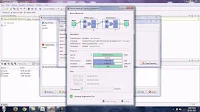AutoCAD Civil 3D Essential Training Course
AutoCAD Civil 3D Essential Training Course [Size: 1.03 GB] ... AutoCAD Civil 3D software is a design and documentation solution for civil engineering that supports building information modeling (BIM) workflows. By learning to use AutoCAD Civil 3D, you can improve project performance, maintain consistent data, follow standard processes, and respond faster to change. This course gets you up and running with AutoCAD Civil 3D. First, instructor Josh Modglin shows how to model a surface, lay out parcels, and design geometry, including the making of horizontal alignments and vertical profiles. Next, Josh demonstrates how to create corridors, cross sections, pipe networks, and pressure networks. Then, he covers working with feature lines and grading objects, and how to share your data. He wraps up by providing an overview of plan production tools.
Topics include: - Navigating the Civil 3D interface - Using point groups and description keys - Importing survey data - Managing figures - Creating and analyzing surfaces - Creating parcels - Working with alignments - Working with profiles and profile views - Working with assemblies and subassemblies - Creating Basic and Advanced Corridors - Using an Intersection Object - Making sample lines, cross sections, and section views - Creating a pipe network - Understanding pressure parts - Creating and editing feature lines - Creating and editing grading objects - Sharing and referencing data.
Topics include: - Navigating the Civil 3D interface - Using point groups and description keys - Importing survey data - Managing figures - Creating and analyzing surfaces - Creating parcels - Working with alignments - Working with profiles and profile views - Working with assemblies and subassemblies - Creating Basic and Advanced Corridors - Using an Intersection Object - Making sample lines, cross sections, and section views - Creating a pipe network - Understanding pressure parts - Creating and editing feature lines - Creating and editing grading objects - Sharing and referencing data.





